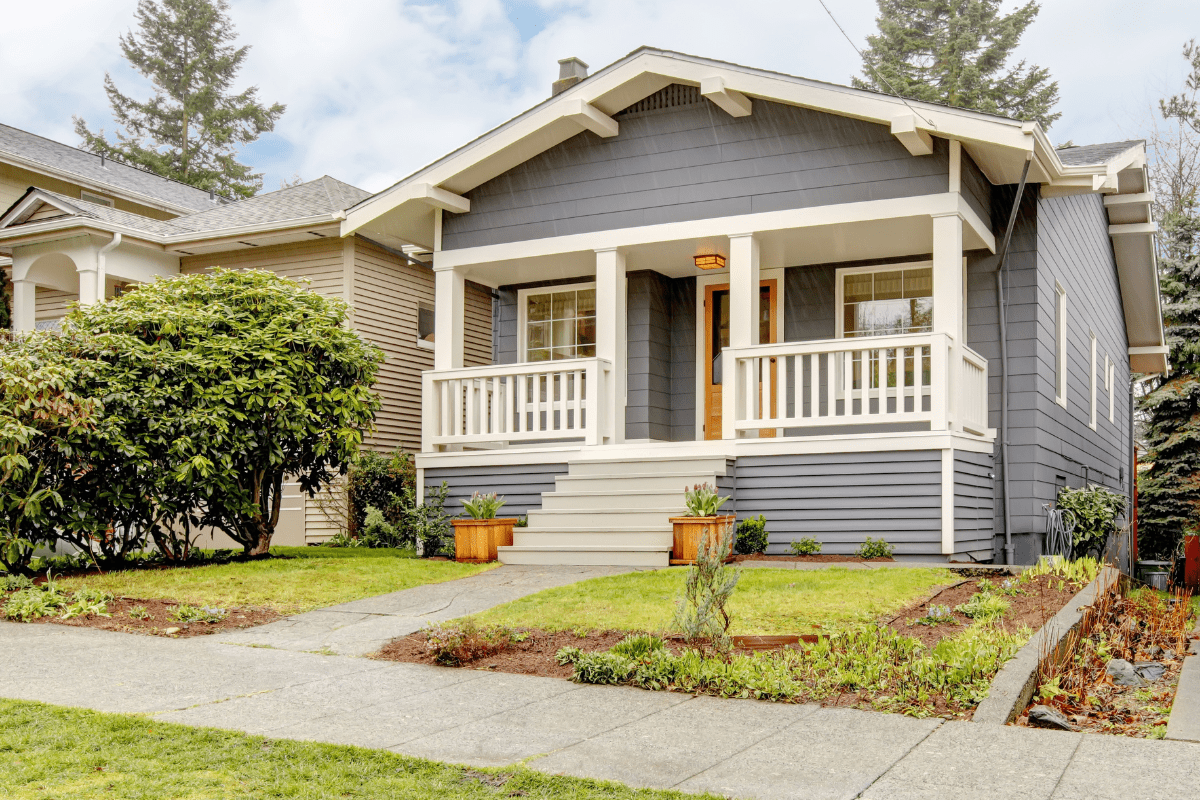Ever wonder why that house on the corner looks like a cardboard box with windows? Or why your neighbor's Victorian makes you feel like you're living next to a wedding cake? Nebraska's neighborhoods are basically an outdoor museum of American home design, and once you know what you're looking at, every drive becomes a treasure hunt.
The box that conquered Nebraska
Let me tell you about the most popular house style you've never heard of, even though you probably drove past 50 of them this morning. The American Foursquare is Nebraska's architectural equivalent of a reliable pickup truck – not fancy, but it gets the job done and lasts forever.
Why everyone's great-grandparents lived in a cube
These homes are literally square boxes with a pyramid on top. I'm not being mean; that's the actual design philosophy. Built from the 1890s through the 1930s, they offered maximum living space on minimal lots, which made them perfect for Nebraska's growing cities. North Omaha contains possibly the highest concentration of these boxy beauties in the state.
Drive down Spencer Street between North 27th and 26th Streets, and you'll see them lined up like architectural soldiers. Each one features:
- Two and a half stories of pure efficiency
- That signature pyramidal hip roof
- A dormer poking out like a sleepy eye
- Front porch perfect for judging neighbors
- Four rooms per floor (hence "Foursquare")
The best part? Many of these were Sears catalog homes that cost about $3,500 in 1935. Yes, you could literally mail-order your house. Amazon Prime, eat your heart out. The compact design meant one furnace could heat the whole thing, which was crucial when Nebraska winters decided to show off.
Ranch homes ate the suburbs (and we loved it)
After World War II, Nebraska went horizontal. Ranch homes spread across the landscape faster than gossip at a church potluck, and by the 1950s, they accounted for 9 out of 10 new houses nationally.
The American Dream, now with attached garage
If you've ever lived in a Nebraska suburb built between 1945 and 1980, congratulations – you've experienced Ranch life. These low-slung homes revolutionized how we lived, mainly by acknowledging that cars existed and maybe we should park them somewhere besides the street.
West Omaha's Longview Addition perfectly captures this era. Developers marketed these as "Dream Homes of Longview" and "Ranch Beauties," which sounds like a beauty pageant for houses. The T.H. Maenner Company and others cranked out entire neighborhoods of these homes faster than you could say "white picket fence."
Key features that scream "Ranch":
- Everything on one floor
- Attached garage (revolutionary!)
- Picture windows bigger than TVs
- Low roofs that make them look relaxed
- Front door nowhere near the center
The Ranch style worked because it matched how people wanted to live – casually, with easy access to the backyard barbecue and the car. Plus, no stairs meant grandma could visit without anyone worrying about hip replacements.
Craftsman homes: When houses had more built-ins than your smartphone
Between 1910 and 1940, Nebraska embraced the Craftsman movement like it was the last piece of pie at Thanksgiving. These homes emphasized handcrafted details and natural materials, basically the opposite of today's particle board specials.
Your great-aunt's house with all the woodwork
Lincoln alone has over 1,000 bungalows, which is either impressive dedication to a style or evidence that nobody could agree on anything else. Omaha's Field Club Historic District showcases some gorgeous examples, and if you cruise through North Omaha's Crown Point Avenue, you'll see why people fell in love with these homes.
What makes a Craftsman identifiable from your car:
- Wide front porch with thick, tapered columns
- Exposed rafter tails (the boards sticking out under the roof)
- Windows grouped in threes or fours
- Natural wood everywhere
- Low profile that hugs the ground
The killer feature? Built-in everything. Bookcases, window seats, buffets – these homes had more storage than a Swedish furniture store. Many arrived as Sears catalog kits shipped by railroad, proving that flat-pack furniture has been torturing Americans for over a century.
Victorian homes: Because sometimes more is more
Nebraska's Victorian homes from the 1860s through 1910s are what happens when architects discover they can add infinite decorative elements and nobody will stop them. These homes celebrated excess in the best possible way.
When your house doubles as a wedding cake
The Edgar Zabriskie House at 3524 Hawthorne Avenue in Bemis Park looks like someone gave a carpenter unlimited overtime and told them to go wild. Built in 1889, it features enough decorative woodwork to keep a restoration expert busy until retirement.
Victorian variety pack includes:
- Queen Anne (the fancy one with turrets)
- Folk Victorian (Victorian on a budget)
- Italianate (flat roof, tall windows)
- Gothic Revival (pointy everything)
The John P. Bay Mansion at 2024 Binney Street went full Queen Anne in 1895, with asymmetrical everything and more gables than you can count. These homes pop up in Omaha's Gold Coast Historic District and historic downtowns across the state. The wraparound porches weren't just for show – they provided crucial shade and wind protection, proving that even Victorian architects occasionally thought about practical matters.
Colonial Revival: Making America symmetrical again
From 1900 to 1950, Nebraskans decided that maybe those colonial folks were onto something with their obsession with balance and order. Colonial Revival homes brought symmetry back to neighborhoods that had gone wild with Victorian excess.
Everything in its place, and two of everything
Drive down Florence Boulevard in Omaha or through the Field Club Historic District, and you'll see these tidy homes standing at attention. During the style's peak from 1910 to 1930, about 40% of American homes went Colonial Revival, because apparently we're all suckers for a centered front door.
Spot them by looking for:
- Perfect symmetry (door in middle, windows balanced)
- Multi-pane windows (usually 6 over 6)
- Classical details like dentil molding
- Front door with sidelights
- Columns that actually look like columns
The Dutch Colonial variant added gambrel roofs that look like barn roofs, because nothing says "traditional American values" like borrowing from Dutch farmers. These homes projected stability and respectability, which was exactly what Nebraska's growing middle class wanted their neighbors to think about them.
The rare birds: Styles you'll brag about spotting
Not every Nebraska neighborhood features these architectural celebrities, but when you spot one, you'll want to pull over and take a photo.
Prairie School: Frank Lloyd Wright slept here (once)
Nebraska has exactly one Frank Lloyd Wright house – the Harvey P. Sutton House in McCook. Built between 1905 and 1908, this 4,000-square-foot showpiece contains 7,200 linear feet of quarter-sawn oak trim, which is probably more fancy wood than in all of McCook's other houses combined.
Prairie School features include:
- Horizontal lines everywhere
- Overhanging eaves that create shadows
- Grouped windows in bands
- Natural materials that blend with landscape
- Roofs that seem to float
St. John's AME Church at 2402 N. 22nd Street in Omaha shows how the Prairie aesthetic worked on churches too, proving that horizontal emphasis is basically universal.
Mid-Century Modern: When space age came to the suburbs
The 1950s through 1970s brought us homes that looked like they were designed for the Jetsons. Indian Hills in West Omaha has the best collection of Mid-Century Modern homes in Nebraska, many designed by Don Polsky, who trained with modernist master Richard Neutra.
These homes feature:
- Flat roofs (snow? what snow?)
- Floor-to-ceiling windows
- Open floor plans before HGTV existed
- Clean lines with zero fussiness
- Integration with the landscape
The Behlen House in Columbus (1958) by the Leo A. Daly firm showcased local steel building products, because nothing says "modern" like using your own factory's materials for your house.
Today's trends: Everything old is new again
Contemporary Nebraska builders have discovered two things: people love farmhouses they'll never farm, and everyone suddenly cares about energy bills.
Modern Farmhouse: For people who think chickens are decorative
The Modern Farmhouse trend combines nostalgic farm elements with the modern amenities necessary for people who think "roughing it" means slow WiFi. Board-and-batten siding, metal roofs, and enormous windows create homes that would confuse actual farmers but photograph beautifully for Instagram.
Going green without going broke
Heritage Homes of Nebraska won the 2019 National Green Home of the Year Award, proving that Nebraskans can be eco-friendly when it saves money. These homes feature:
- Spray foam insulation from soybeans
- LED lighting throughout
- LEED Platinum certifications
- Solar panels that confuse birds
- Smart home tech everywhere
Your neighborhood decoded
Understanding neighborhood patterns helps you date areas faster than carbon testing. In Omaha, the Gold Coast has Victorian mansions where lumber barons showed off, while Dundee-Memorial Park features streetcar suburb charm from the 1880s-1920s.
Lincoln's Near South neighborhood preserves Victorian grandeur, while Havelock and College View stay humble with their Craftsman bungalows. Smaller towns tell different stories – railroad towns like McCook have Victorian clusters near depots, while agricultural communities show German and Czech influences in their practical designs.
The architects who shaped Nebraska
While Frank Lloyd Wright only blessed Nebraska with one house, local architects made bigger impacts. George A. Berlinghof designed over 50 buildings after setting up shop in Beatrice. Leo A. Daly founded his firm in 1922 and went on to design Boys Town, proving that Nebraska architects could think big.
But let's be honest – Sears, Roebuck and Company probably shaped more Nebraska neighborhoods than any fancy architect. Between 1908 and 1940, they shipped house kits by railroad, democratizing decent design for regular folks who just wanted a nice place to raise kids and complain about property taxes.
Quick identification guide for amateur architecture detectives
When you're driving around playing "name that house style," use this cheat sheet:
Check the roofline first:
- Pyramid top = American Foursquare
- Barely there = Ranch
- Complex angles = Victorian
- Floating horizontal = Prairie
Window wisdom:
- Grouped in bands = Prairie or Craftsman
- One giant picture window = Ranch
- Tall and narrow = Victorian
- Perfectly balanced = Colonial Revival
Age indicators:
- Pre-1920 = Victorian, Craftsman, or Foursquare
- 1920-1945 = Colonial Revival
- Post-1945 = Ranch everywhere
- 1950s-1970s = Possible Mid-Century Modern
- 2000s+ = Modern Farmhouse or green builds
The neighborhood is your museum
Nebraska's residential architecture tells the story of American dreams, prairie practicality, and the eternal human desire to have a nicer house than the neighbors. From Victorian wedding cakes to Foursquare boxes, from Ranch sprawl to Modern Farmhouse fantasy, each style reflects its era's values, technologies, and definition of "home."
Next time you're driving through any Nebraska neighborhood, slow down and really look. That boring box might be a century-old Sears catalog home. That low Ranch could be where someone's grandparents hosted 40 years of Thanksgiving dinners. Even that new Modern Farmhouse represents someone's dream, even if they've never touched a cow.
Understanding these architectural patterns transforms routine drives into adventures through living history. Every neighborhood becomes a chapter in Nebraska's story, written in wood, brick, and the occasional unfortunate vinyl siding choice. So grab your keys, pick a neighborhood you've never explored, and start reading the stories these houses tell. Just try not to crash while craning your neck to check out someone's Victorian turret.





